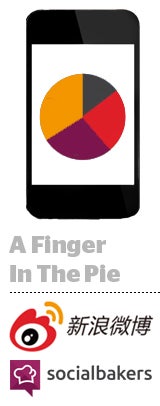 Analytics on Sina Weibo used to be fairly rudimentary – number of friends, number of followers, basic engagement metrics and the like.
Analytics on Sina Weibo used to be fairly rudimentary – number of friends, number of followers, basic engagement metrics and the like.
“The previous version wasn’t that good,” admitted Bryan Cheng, VP of commercial products and platforms at Weibo, commonly described as a sort of Twitter/Facebook mashup. “The point is to provide more actionable data.”
Most big social platforms develop their own built-in analytics. But Weibo, one of the largest social media players in China, decided to bring in an independent player.
“When businesses work with us, we want them to have a neutral perspective on their performance,” Cheng said. “We’re the platform provider, but we can’t do everything ourselves.”
Since May, Weibo has been working exclusively with Prague-based social media metrics firm Socialbakers, which maintains an office in Singapore, to jointly develop a Facebook Insights-like product to help brands visualize and measure the performance of paid and organic posts, run competitive analysis and track use trends by age, gender and geo.
The duo launched the fruits of their labor in October in the form of Weibo Data Center, a paid advanced analytics service aimed at businesses. A stripped-down free version, available since the end of June, already has around 200,000 users.
Social metrics are all well and good, but, “at the end of the day, it’s all about ROI,” Cheng said.
Advertisers need a feedback loop if they’re going to spend. Which is why Weibo and Socialbakers are in the midst of adding ad management capabilities to the next version of Data Center, said Jiri Voves, head of product at Socialbakers and one of the company’s co-founders.
In addition to tracking ad performance, Weibo is planning to get more involved in helping its advertisers actually run their campaigns, à la Facebook, through its open API, tapping into profile data to target specific audiences and create lookalikes.
Weibo has 212 million monthly active users, according to its most recent earnings report. It’s a potentially rich audience – if you do something with it.
“Social media provides its users with quite a lot of metrics, but if you don’t know how to action them, they aren’t being used to their full value,” Voves said
Although advertising forms a core part of Weibo’s monetization strategy – of Weibo’s total revenue of $107.8 million in Q2 2015, nearly $88 million came from advertising, up 47% YoY – Weibo is also attracting advertisers by using content to dig into specific vertical areas.
“All these social platforms are trying to move toward being a content delivery network because all content is trying to be social,” Socialbakers co-founder and executive chairman Jan Rezab noted in a previous interview with AdExchanger.
In Weibo’s case, the goal is to create a sort of virtuous cycle in which Weibo positions itself as the go-to resource on a particular topic – automobiles, for example – encouraging influencers and auto experts to post car-related content. That, in turns, leads individual users to organically post content of them own, perhaps information about their favorite car brands, their driving experiences or the next car they’re planning to buy.
The combined force of that vertical-specific activity enriches the value of the Weibo audience to car brands, which can then target users based on their stated preferences.
“More user data drives more dollars,” Cheng said. “It only makes sense for us to provide tools on top of this data to help our businesses run organic marketing campaigns, deliver ads to accelerate their growth and then be able to understand what it all means in the social environment.”














